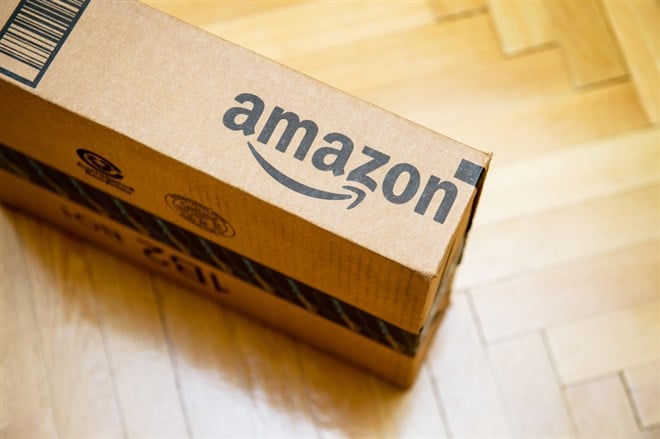
Don’t be alarmed when Amazon.com’s (NASDAQ: AMZN) share price is less than $200. The e-commerce giant is not the subject of an antitrust lawsuit nor is brick-and-mortar retail staging a massive retro comeback.
Instead, a newly announced stock split will soon make Amazon stock the most affordable it has been in more than a decade. In reality, the roughly $1.5 trillion valuation will stand pat—and remain a far cry from what it was when online shopping was still a novel concept. Amazon will also remain in a very select trillion market cap club that includes Apple, Microsoft, and Alphabet.
So while the common corporate gimmick does nothing to alter Amazon’s sky high market value, it does change the perception of the stock to attainable for retail investors who otherwise wouldn’t bother with a one or two share position.
The split combined with a concurrently announced buyback program has Amazon looking shareholder friendly again. And with the stock trading more than 20% below its all-time high set in July 2021, it’s no wonder Wall Street is as bullish as ever.
What Did Amazon.com Announce?
Last week Amazon’s board of directors approved a 20-for-1 stock split. This means that for every one share held investors will receive 20 shares. Not an act of charity, however - the share price will become 1/20th of what it was prior to the split, so in effect shareholders’ positions won’t change.
Nevertheless, the news was greeted positively by traders who bid Amazon up 6% on March 9th. It marked the first time the company has enacted a split since a more modest 2-for-1 split in September 1999. My how things have changed with Amazon now a household name and its delivery vans a daily fixture on America’s roadways.
Assuming the split gets approved at the company’s May 25th annual meeting, shareholders will see the extra shares hit their accounts in early June. The new slimmed down price will be in effect as of trading on June 6th.
Adding to the enthusiasm was an announcement of a $10 billion repurchase program that will allow Amazon to buy back its own stock as it sees fit. The program, which replaces the board’s previous $5 billion authorization, implies that Amazon is starting to think that its stock is undervalued—and should provide a floor as to how low the stock can go after it dipped below $2,700 earlier this month.
Why is Amazon.com’s Stock Splitting?
At the surface, Amazon’s decision to enact a mammoth split is a mathematical wash. However, it sends a subtle message that the company is doing well and can therefore make such a move when most opt for the standard 2-for-1 split.
At a time when fractional shares of high priced stocks can be purchased on several trading platforms, the chance to buy full shares is somewhat irrelevant. Yet the split does make Amazon more accessible to retail traders and institutional funds alike.
Another motivation behind the split may be Amazon’s interest in joining the coveted Dow-30, which would expose it to a broader investor universe. Since the popular index is price rather than market cap weighted, a lower price tag would seem to improve the chances that Amazon gets the nod. It's undeniably a modern bellwether for the U.S. economy. Tech giants like Apple, Alphabet, and Nvidia have recently gone the split route but thus far only Apple has made its way into the Dow.
Is Amazon.com Stock a Buy?
Amazon’s split-buyback double whammy showed why it is not only a beloved name in online shopping but also among sell-side research firms. The shareholder-friendly moves have been well received by analysts who were already enamored with the company’s long-term growth prospects.
Four firms including Morgan Stanley and Bank of America have reiterated ‘buy’ ratings since Amazon delighted the market with a much needed catalyst. Since last month an additional 29 analysts have agreed that the stock is still a buy despite lingering concerns about a growth slowdown and the impact of rising costs. None have called it a sell or even a hold, making Amazon perhaps the most unanimously bullish mega cap name on the Street
Amazon’s return to the sub $3,000 level presents a glorious opportunity to ride an e-commerce boom that will inevitably slow from pandemic levels but still experience strong growth as the decade progresses. The high margin AWS cloud business also has tremendous growth ahead with the global digital transformation in the early stages.
Analysts’ most recent Amazon price targets imply 40% to 50% upside. When the share price “sale” goes live in a few months, look for renewed attention on the stock to drive it back to split-adjusted record highs.
Before you consider Amazon.com, you'll want to hear this.
MarketBeat keeps track of Wall Street's top-rated and best performing research analysts and the stocks they recommend to their clients on a daily basis. MarketBeat has identified the five stocks that top analysts are quietly whispering to their clients to buy now before the broader market catches on... and Amazon.com wasn't on the list.
While Amazon.com currently has a Moderate Buy rating among analysts, top-rated analysts believe these five stocks are better buys.
View The Five Stocks Here
Wondering what the next stocks will be that hit it big, with solid fundamentals? Enter your email address to see which stocks MarketBeat analysts could become the next blockbuster growth stocks.
Get This Free Report
Like this article? Share it with a colleague.
Link copied to clipboard.
